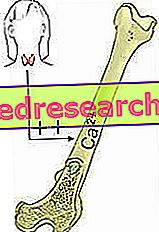Generality
Calcitonin is a polypeptide hormone secreted by the parafollicular cells (C cells) of the thyroid .

This hormone acts at the bone and renal level, performing functions in many ways opposed to those covered by the parathyroid hormone. In particular, calcitonin increases renal excretion of phosphorus and stimulates the reabsorption of calcium, favoring its deposition in the bones.
Thanks to these properties, calcitonin opposes the excessive rise in calcemia (a parameter that expresses the concentration of Ca2 + in the plasma), increasing bone mineralization.
In a single term, calcitonin has hypocalcemic properties .
As is to be expected, the secretion of this hormone increases in response to hypercalcaemia, and vice versa.
By virtue of its mineralizing action, calcitonin is used in the therapy of Paget's disease, a genetically determined condition in which the bones are weak due to the hyperactivity of the osteoclasts (large cells deputed to bone erosion).
| serum calcium | phosphorus |
| (concentration of calcium in the blood) | (concentration of inorganic phosphate in the blood) |
| Normal values: 10 mg / 100 ml | Normal values: 5 mg / 100 ml |
| CALCITONINA - normal values - | |
| Man: less than 19 pg / ml | Woman: less than 14 pg / ml |
The ability of calcitonin to increase bone strength has attracted the interest of scientists, thanks to its enormous therapeutic potential. Despite this, some shadows still remain on its mechanism of action. The most plausible hypothesis is that calcitonin covers important roles above all for skeletal development and to preserve calcium deposits during pregnancy and lactation.
The role of the hormone in adult life is more discussed. In fact, patients subjected to thyroid removal do not show significant alterations to calcemia. Furthermore, even hyperproducing individuals of calcitonin do not report any particular symptoms attributable to the altered calcium homeostasis. For all these reasons, the usefulness of calcitonin in the treatment of osteoporosis is controversial. We must not forget that the health of our bones actually depends on an integrated network of numerous elements:
estrogens, testosterone, IGF-1, cortisol, thyroid hormones, but also the type of diet, the degree of physical activity and sun exposure are just some of the factors that influence bone mineralization more closely.
What's this
Calcitonin is a peptide hormone produced by the C cells of the thyroid. The secretion of this protein in the blood is stimulated by the increase in blood calcium.
The main biological effect of calcitonin is to reduce calcemia, by inhibiting osteoclastic bone resorption.
In the case of benign hyperplasia of C cells (a pathology that causes an increase in the number of parafollicular cells) or medullary carcinoma of the thyroid (malignant tumor of the C cells of the thyroid), the serum calcitonin is typically produced in excess. The measurement of its concentration in the blood is therefore used in the diagnosis of these conditions.

Why do you measure
The calcitonin test measures the amount in the blood.
The exam can be used as:
- Support for the diagnosis and monitoring of two rare thyroid diseases: benign hyperplasia of C cells and medullary thyroid carcinoma (CMT) ;
- Screening for the evaluation of the risk of developing Multiple Endocrine Neoplasms of type 2 (MEN2 ), a syndrome associated with various pathologies, including CMT and pheochromocytoma.
Considering that about 20-25% of medullary thyroid carcinomas are hereditary, the calcitonin test could be used to follow at-risk subjects, especially those with a family history for this type of tumor or with a mutation in a specific gene ( RET).
Medullary thyroid carcinoma (CMT) represents about 5-10% of all tumors affecting the gland; Of these:
- in 75-80% of cases the neoplastic process is sporadic (that is, it manifests itself in the absence of familiarity).
- in 20-25% of cases, on the other hand, these are forms associated with inherited mutations in the RET gene, which lead to the development of multiple endocrine neoplasms of type 2 (MEN2) .
The RET gene mutation is inherited in an autosomal dominant manner. This means that the presence of only one of the two copies of the mutated RET gene - be it of maternal or paternal origin - is sufficient to increase the risk of developing CMT.
The measure of calcitonin is not useful, instead, in the evaluation of the state of calcium metabolism, since its role in the regulation of calcium levels is of minor importance compared to that played by parathormone and 1, 25-dihydroxyvitamin D.
If the calcitonin levels are normal, but the clinician suspects the presence of thyroid disorders, the stimulation test may be required. This latter evaluation is more sensitive than the isolated measurement of calcitonin in the blood and can recognize a medullary carcinoma or benign hyperplasia already in the early stages of the disease.
Besides the measurement of calcitonin, the doctor can also prescribe the simultaneous execution of other tests that investigate the thyroid function (TSH, T3 and T4) .
When is it prescribed?
Calcitonin measurement tests may be required if the doctor suspects C-cell hyperplasia or CMT. In this case, patients may show signs and symptoms such as:
- Nodule or swelling in the front of the neck;
- Pain in the throat or in the frontal part of the neck;
- Variations of the voice and hoarseness;
- Difficulty swallowing or breathing;
- Persistent cough.
In the case of patients treated for CMT, the calcitonin test is normally required at regular intervals to evaluate the effectiveness of therapeutic treatments and any relapses.

Normal values
- Females: 0 - 5.5 pg / mL
- Males: 0.4 -18.9 pg / mL
Note: the reference intervals may differ in the various laboratories, as they depend on many factors, such as analytical methods and instrumentation in use. For this reason, it is preferable to consult the normality values reported directly on the analysis report. It should also be remembered that the results must be assessed as a whole by the medical doctor who knows the patient's medical history.
High Calcitonin - Causes
High levels of calcitonin in the blood ( hypercalcitoninemia ) indicate excessive production of the same, probably due to the presence of two rare thyroid diseases:
- C cell hyperplasia;
- Medullary thyroid carcinoma (CMT).
Calcitonin values can be high even in the presence of:
- Hypergastrinemia (high gastrin levels are typically found in gastrinoma or chronic atrophic gastritis);
- Hypercalcemia (various causes, including hyperparathyroidism);
- Other thyroid diseases (some thyroiditis, follicular carcinoma and papillary thyroid carcinoma);
- Lung, breast and pancreatic cancer;
- Neuroendocrine neoplastic processes (they can secrete ectopic calcitonin), such as enteropancreatic tumors, insulinoma, gastric carcinoid and pulmonary microcytoma;
- Kidney failure;
- Zollinger-Ellison syndrome;
- Verner-Morrison syndrome or VIPoma (rare form of pancreatic cancer associated with the production of the VIP hormone, vasoactive intestinal peptide);
- Pernicious anemia.
The concentration of calcitonin may increase with the use of drugs (such as epinephrine, glucagon, omeprazole and oral contraceptives) and is normally elevated in newborns and pregnant women.
Low Calcitonin - Causes
Low calcitonin values indicate the improbability that the patient's complaints are due to the presence of C-cell hyperplasia or medullary thyroid carcinoma.
If the therapeutic treatments for CMT, such as the removal of the thyroid, and often also of other surrounding tissues, are successful, the calcitonin levels decrease to very low levels; the permanence of this status indicates the success of the treatment.
How to measure it
To perform the calcitonin test, it is sufficient to take a blood sample from the vein of an arm. In the laboratory, then, the dosage is performed, ie the measurement of the concentration of calcitonin in the blood sample taken.
Calcitonin provocation test
In addition to the classical analysis, there is an exam called "calcitonin provocation test" . This type of examination is prescribed by the doctor when the values measured with the classic test are normal, but a clinical suspicion persists.
In the provocation test, a blood sample is taken before the intravenous administration of a known amount of calcium or pentagastrin, necessary for stimulating the production of calcitonin. The effects of stimulation are measured by collecting multiple blood samples, taken at regular intervals in the minutes following the stimulation. Patients with C-cell and / or CMT hyperplasia show markedly increased calcitonin levels.
Preparation
Before the calcitonin test it is necessary to observe a fast of at least 8 hours, during which a small quantity of water is allowed.
Interpretation of Results
High levels of calcitonin indicate an excessive production of the same, probably due to the presence of hyperplasia of C cells and CMT. However, to define a diagnosis, the doctor must use other methods, such as performing a thyroid biopsy or ultrasound methods.



